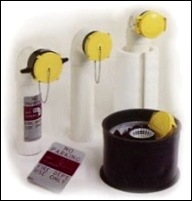Dry Hydrant Information
What is a dry hydrant?
 Dry hydrant systems are generally non-pressurized and are designed
for use in a drafting application. The installation of these systems
on alternate water supplies can provide year-round water sources
for fire suppression. Installed in strategic areas, five or more
dry hydrants can become the "water supply system" for
rural fire departments where pressurized systems are either not
available or where lines are to small to support needed fire flows.
In many cases dry hydrants are called upon to supplement pressurized
systems in municipal areas where low water pressure exist or where
back-up systems are desirable for emergency preparedness. Dry hydrants
can also be used in tanker shuttle operations and provide an excellent
source of water for pump test.
Dry hydrant systems are generally non-pressurized and are designed
for use in a drafting application. The installation of these systems
on alternate water supplies can provide year-round water sources
for fire suppression. Installed in strategic areas, five or more
dry hydrants can become the "water supply system" for
rural fire departments where pressurized systems are either not
available or where lines are to small to support needed fire flows.
In many cases dry hydrants are called upon to supplement pressurized
systems in municipal areas where low water pressure exist or where
back-up systems are desirable for emergency preparedness. Dry hydrants
can also be used in tanker shuttle operations and provide an excellent
source of water for pump test.
Equal ISO credit can be obtained on dry hydrants as would be obtained on a pressurized hydrant. Credit can be earned in several categories: inspection, water supply and as a water system with the installation of five (5) or more. Flows may be considered at the point of use, within a 1,000 feet, or may be transported to another location using a water shuttle.
Heads are designed in many shapes and sizes to fit the application. Generally most applications will have a large intake strainer located in the water source to prevent fish and other debris from entering the piping system during drafting. See "Strainers" for your specific application.
NFPA 1142 "Standard on Water Supplies for Suburban & Rural Fire Fighting" outlines planning, permits, design, and installation of dry hydrant systems. Many of the design sketches found in this publication were provided by ETT.
